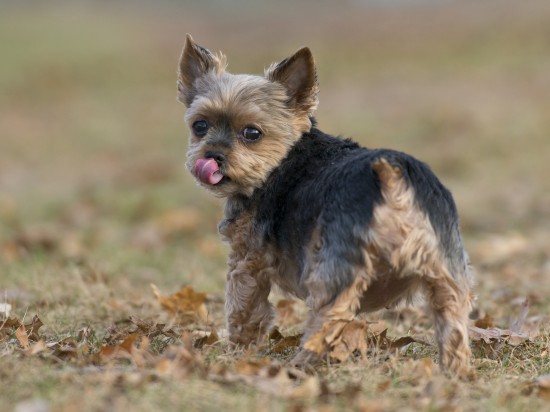

Otherwise known as Legg-Calvé-Perthes Syndrome, this disease affects hip joints in small dog breeds. The condition usually rears it's ugly head early and is seen in puppies anything from between 3 to 13 months of age. It's a disease that Yorkshire Terriers and Westies are prone to suffer from and which owners need to watch out for. However, other small breeds can suffer from the condition too.
The condition occurs when the head of the femur bone found in a dog's hind leg degenerates and this results in the disintegration of the hip joint. The condition worsens, leading to painful joint and bone inflammation, otherwise known as osteoarthritis. However, nobody actually knows what causes Legg-Calvé-Perthes Disease although it's generally accepted that abnormal blood supply to the femoral head may be a contributing factor.
Legg-Calvé-Perthes Disease is more commonly seen in toy, miniature and small dog breeds and symptoms normally appear early in a puppy's life, as young as 3 months old. The following breeds appear to be more predisposed to the condition:
As previously mentioned, puppies as young as three months old can show early signs of the condition and would need to be taken to the vet in order for a diagnosis to be made and a treatment/surgery organised. The symptoms that may be present and which you need to watch out for are as follows:
The exact causes of Legg-Calvé-Perthes Syndrome is unknown but research into the condition strongly suggests it could be due to poor blood supply to the head of the femur bone.
You would need to have your dog's complete medical history in order for a vet to assess their condition before they perform a thorough physical examination of your pet. The vet will focus on the affected limb and joint area, and may include X-rays which will identify any changes in the bone and the hip joint. In the early stages, a slight widening of the joint space will be apparent on the X-ray as well as a decrease in bone density. A thickening of the femoral bone neck will also be clearly visible and there could even be a fracture of the femoral neck too, which causes puppies tremendous pain.
In some cases rest and pain killers as well as cold packs on the hip joint do help alleviate the pain and discomfort, and are used to treat dogs showing signs of the condition. However, vets usually recommend surgery followed by a lot of after care and vigorous exercise. Vets will normally recommend physical therapy, lots of exercise and a reduced diet after dogs have undergone the necessary surgery, and they will need to re-examine the dog every few weeks too.
The importance of after care cannot be stressed enough, and the same goes for regular exercise and the much needed physical therapy. Rehabilitation is the key to a dog making a full recovery after they have received surgery on their hip. Often small lead weights are attached just above the hock joint, much like ankle bracelets, which is one way of encouraging a dog to put weight on the treated leg as soon as possible.
Vets usually like to see a dog that has undergone surgery every two weeks to make sure the physiotherapy is working well and this goes for the prescribed exercise too. It normally takes anything from three to six months for dogs to fully recover from the surgery, although sometimes it can take a lot longer. This means owners have to be very patient with their dogs during the recovery period and help them as much as they can. Diets have to be well managed too because some dogs may have a tendency to put on too much weight during the recovery process.
People interested in adopting or buying a Manchester Terrier should be aware they are predisposed to suffering from Legg-Calvé-Perthes Disease and that any dog with the condition should not be used for breeding purposes.
After a dog has undergone surgery, it is vitally important for them to be given regular and vigorous exercise in order to maintain muscle and to improve the stability of the hip joint. The importance of maintaining endurance as well as cardiovascular fitness cannot be stressed enough, and the same goes for building up the articular cartilage around the hip joint which can only be achieved through exercise.
Many vets recommend hydrotherapy for dogs that have undergone the surgery too. This helps encourage joint mobility and well as being a great way to stabilise the hip joint by building up muscle mass safely and quickly without putting too much pressure on the joint. Regular swimming exercise is hard to beat when it comes to rehabilitation because it increases the range of movement in the joint whilst at the same time increasing muscle strength but without the impact of putting a paw to the ground.
Legg-Calvé-Perthes Disease is a condition that affects small dog breeds with some being more predisposed to it than others. Manchester Terriers can inherit the condition from their parents which is why any dog with Legg-Calvé-Perthes Disease should not be used for breeding purposes. However, it is a treatable disease through surgical intervention, although the recovery period can be quite long. The good news is the majority of dogs do make a full recovery once they have had the surgery.
Copyright © 2005-2016 Pet Information All Rights Reserved
Contact us: www162date@outlook.com